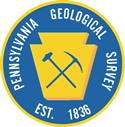Organization |
||
 Our mission - To serve the citizens of Pennsylvania by collecting, preserving, and disseminating impartial information on the Commonwealth's geology, geologic resources, and topography in order to contribute to the understanding, wise use, and conservation of its land and included resources.” The Pennsylvania Geological Survey has been examining Pennsylvania’s geology since 1836, and always with an eye toward meeting the ever-changing needs of the times. Pennsylvania has evolved from a state primarily focused on coal and petroleum resources to one where these still-important commodities compete for attention with other concerns, including finding adequate supplies of water, locating resources for construction and pollution remediation, dealing with geologic hazards such as landslides and sinkholes, and even supporting tourism, which has become an important statewide industry. Providing information that planners can use in making wise decisions on future land use has become an important activity in the 21st century. The Survey's present organization dates to 1919, when it was authorized by the General Assembly “to undertake, conduct, and maintain the organization of a thorough and extended survey of the State, for the purpose of elucidating the geology and topography of the State.” It was also given the responsibility to “put the results of the survey, with the results of previous surveys, into form convenient for reference.” Toward that end, the Survey has published hundreds of books, maps, magazines, and pamphlets, many of which are presently in print. New publications continue to be printed every year, and now we have added the Internet as yet another medium through which we can put our results “into a form convenient for reference.” http://www.dcnr.state.pa.us/topogeo/ Location 400 Waterfront Drive Pittsburgh , PA 15222 |
View more...
|
|
|
ScienceBase brings together the best information it can find about USGS researchers and offices
to show connections to publications, projects, and data. We are still working to improve this
process and information is by no means complete. If you don't see everything you know is associated
with you, a colleague, or your office, please be patient while we work to connect the dots.
Feel free to contact sciencebase@usgs.gov.
|
||